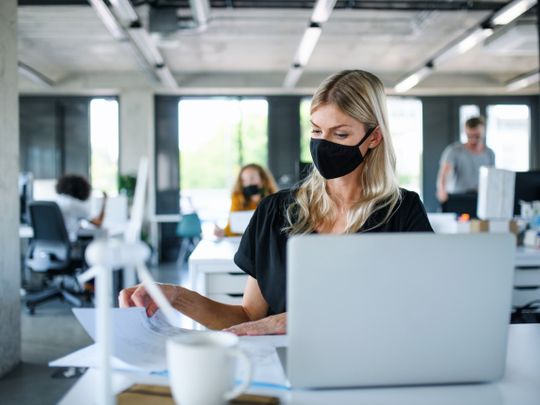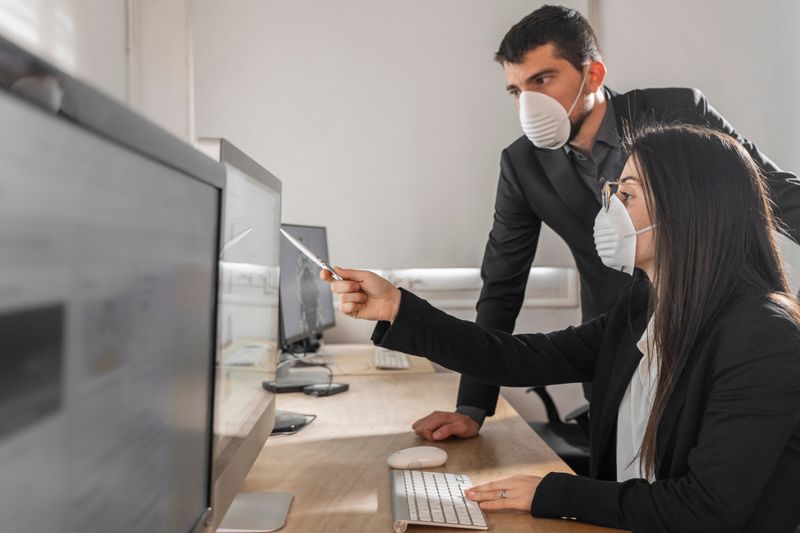
Dubai: As COVID-19 precautionary measures go, nothing can be more sacrosanct than wearing a mask. We get it.
Not wearing mask is an offence under UAE law, with the penalty including a fine as hefty as Dh3,000. We get that too.
Yet, why is it that we find it so difficult to strap that little piece of cloth across our faces, especially over a prolonged period of time?
Office-goers have cut short their time in the office because they can’t bear to be masked all the time. Schools and hospitals, in some parts of the world, we are told, have introduced mask breaks, just so that people can take a breather.

With coronavirus not likely to go away in a hurry and the masks here to stay, Gulf News asked two healthcare experts - Dr Salvin George, Specialist Internal Medicine, Medcare Hospital, Al Safa and Dr Ali Anwar Mohammad, Specialist Pulmonologist, Aster Clinic, Bur Dubai - how best one can cope with this all too essential gear. Here’s what they had to say:
Many say masks are very uncomfortable…
Yes, we hear a lot of complaints to this effect. Some people, especially in western countries, outright refuse to wear the mask. There’s no denying that there is a certain level of discomfort for the wearer. However, with regular use of the mask and habituation, the discomfort levels tend to diminish. And the benefits of wearing a mask far outweigh the discomfort factor.
How do masks actually help check the spread of infection?
Masks have become the new norm since the outbreak of the pandemic. From the experience in the UAE and strict implementation of use of mask in public places, COVID-19 infections as well as all other viral infections have been brought under control to a significant level with the use of masks.
But how does the mask provide protection?
There are two main functions for the mask. Firstly, it protects the person wearing the mask and secondly and more importantly, the current focus is on prevention of transmission of the virus from asymptomatic persons.
As doctors, how do you cope with masks on for long hours?
Being in the medical profession, we have been trained to use masks since time immemorial.
How about sharing some tips?
The best practical tip is to wear a regular mask (not N95) which is just tight enough to fit to the contours of your face, but is not too tight nor too loose.
Avoid touching your mask or face. Avoid masks that are too thick as they make you feel suffocated and hinder communication. With some trial and error, go in for a mask that makes you comfortable and doesn’t pull at the back of your ears.
Is there a time limit to wear a mask at a stretch?
In terms of safety, there is no specific time limit to wear a mask. It differs from individual to individual. Some people feel suffocated wearing a mask for two-three hours, others are comfortable wearing it for a longer time.
Are there any health dangers in wearing a mask for too long? People do complain of suffocation, headaches and breathing difficulties?
Respiratory compromise has not been documented with the use of masks, and carbondioxide levels in healthy individuals are not a concern. Individuals who are involved in sports activities can wear special sports masks that have thin breathable fabric which are marketed by reputed brands.
Can masks be reused?
Masks are not to be reused as they could be contaminated with virus particles which are a potential source for re-infection. The average life span for a mask is up to six-eight hours. Re-usable washable masks are also widely used, but they are best worn outdoors where exposure to potential COVID-19 is a minor possibility. Surgical masks are recommended to be changed every 6 hours as they get soaked from the moisture in our breath. Cotton masks can be washed, dried and reused. N95 masks can be autoclaved by hospital sterilization team if there are shortages in a medical facility.
Do you recommend mask breaks?
Why not? If there are private rooms where individuals can go, they should take a break from their masks, especially to relieve the pressure of the elastic on the ears and the metal band which often hurts the bridge of the nose.
You can take a mask break once in three-four hours. There are no specific guidelines regarding this.
As doctors, do you take a mask break?
Healthcare workers on duty wear masks for very long hours as they are almost always surrounded by patients. They do take mask breaks whenever they can. They also change masks at regular intervals so they don’t feel uncomfortable with a damp mask.








